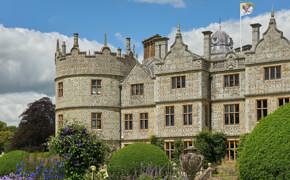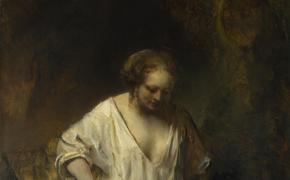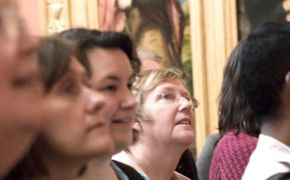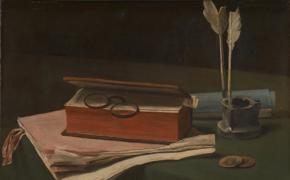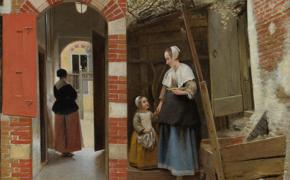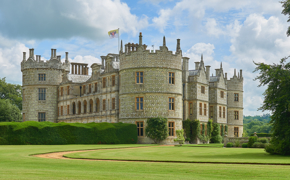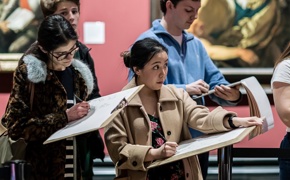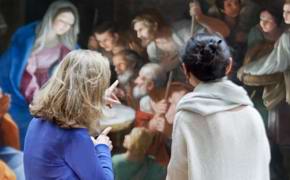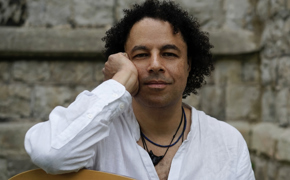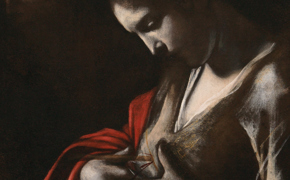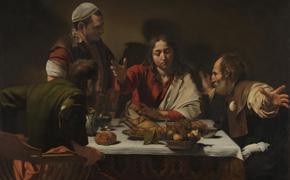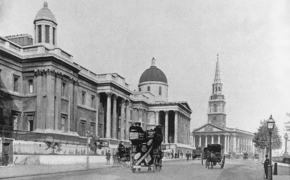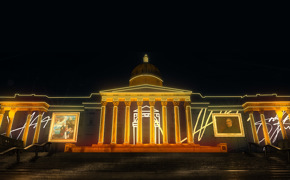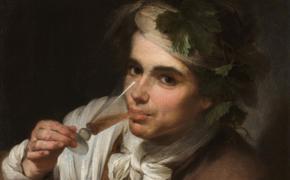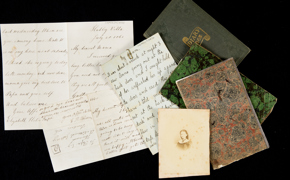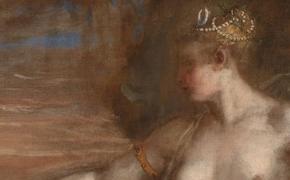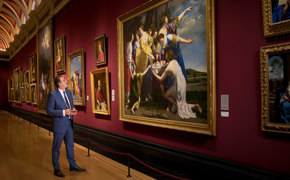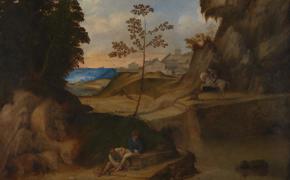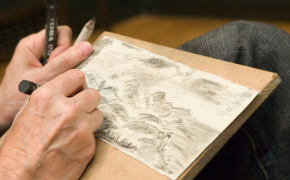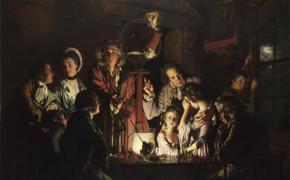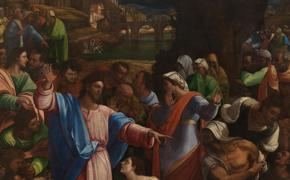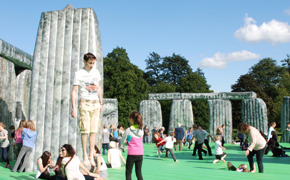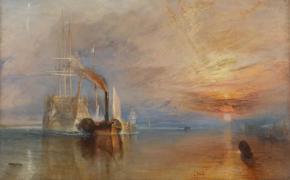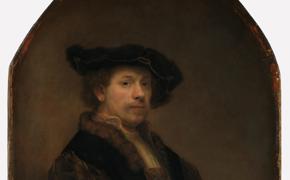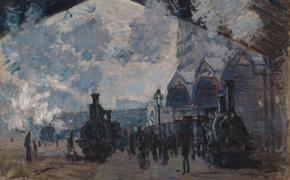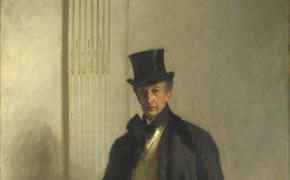
Picture of the month
June 2019: The Story of Griselda, Part I: Marriage
Once upon a time, so the story goes, there was an Italian nobleman called Gualtieri, the Marquis of Saluzzo. He spent his days hunting and playing sports with no interest in settling down, despite pleas from his friends and advisors that he should marry and produce an heir.
Eventually, to please them, he agreed but privately resolved to marry Griselda, a local peasant and the most beautiful girl he had ever seen. Her poor background he thought would spite those who were pressuring him to marry, while her good looks would make married life more bearable. However, once married, he set several trials through which Griselda had to prove her fidelity. After many twists, turns, and testing times for Griselda, during which she again and again showed her faithfulness, the story ends happily.
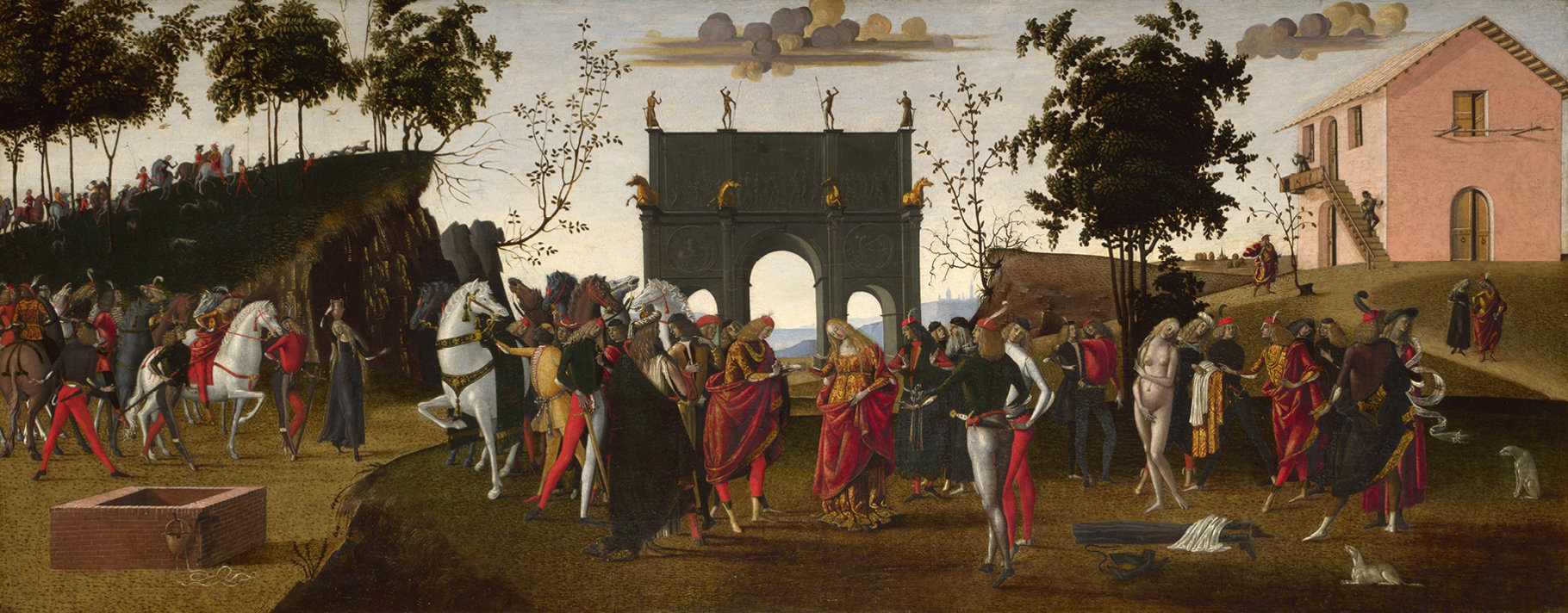
Our three paintings, by a still unknown artist, tell the tale of Griselda and Gualtieri’s courtship, wedding, and married life. This first painting takes us up to the wedding day and begins by showing Gualtieri hunting with his retinue, silhouetted on the crest of the hill in the left background. In the foreground, the Marquis encounters Griselda returning from a well, carrying a water jug on her head and is stunned by her beauty. Over on the right, the Marquis arrives at her house and announces his intention to marry her. Griselda is shown naked, having shed her shabby clothes, and is just about to be dressed in new fine garments. At the centre, there's the finale, with the marriage ceremony taking place in front of a triumphal arch decorated with horses and gilded statuettes.
This much-loved Italian story is thought to have been passed down from generation to generation by Italian storytellers before being set down in print by the 14th-century Florentine poet Boccaccio in his series of novellas, known as the 'Decameron'. The scenes would most likely have been set into the walls of a wooden-panelled room, such as a marriage chamber, and the messages they convey about faith and constancy would have been fitting for the home of a newly wed couple.
Related events
-
Category:Tour, Paid
-
Category:Tour, Free
British Sign Language (BSL) tour
Rembrandt
Tuesday, 23 April 20241 - 2 pm -
Category:Tour, Free
Daily guided tour
Tuesdays, Wednesdays, Thursdays (excluding public holidays)3 - 4 pm -
Category:Course, From £70.50
Thinking about art: Philosophical approaches to art history
Tuesday, 2 April 2024 - Tuesday, 7 May 20243.30 - 5.30 pm BSTOnline event -
Category:Study day, Free
Take One Picture CPD - 2023/2024
Online sessions
Various datesWednesday, 24 April 2024 - FULLY BOOKED1 - 4.30 pm BSTOnline event -
Category:Course, From £70.50
Stories of art: 1700-1800
Wednesday, 17 April 2024 - Wednesday, 22 May 20245.30 - 7.30 pm BSTOnline event -
Category:Talk, Free
Audio Art: Utterly in the picture
Pieter de Hooch’s 'The Courtyard of a House in Delft'
Thursday, 25 April 20241 - 2 pm (drop-in) -
Category:Discussion, From £10
A livestream tour of Longford Castle
Members' live tour and Q&A
Friday, 26 April 20243 - 4.30 pm BSTOnline eventMembers -
Category:Experiences
Friday Lates
Fridays -
Category:Talk, Free
Unexpected views
Friday, 26 April 20246.30 - 7.15 pm -
Category:Music, Free
Andrew Maginley and Emma Curtis
Music from the time of Caravaggio
Friday, 26 April 20247.30 - 8.15 pm (drop-in) -
Category:Talk, Free
Ten-minute talk
Curator's introduction: 'The Last Caravaggio'
Various dates, first upcomingWednesday, 1 May 202412 - 12.10 pm -
Category:Lunchtime talk, Free
Velázquez, portraitist
Friday, 3 May 20241 - 1.30 pm (drop-in) -
Category:Course, From £35.25
Caravaggio: Among the light and shadows
Thursday, 9 May 2024 - Thursday, 23 May 20243.30 - 5 pm BSTOnline event -
Category:Talk, Free
Collecting histories: Tales from the National Gallery
NG200 Members' talk and Q&A
Thursday, 9 May 20246 - 7 pm BSTOnline eventMembers -
Category:Experience, Free
Big Birthday Weekend Late and Light Show
Friday, 10 May 2024 -
Category:Talk, From £18
A tour of celebration
NG200 Members' tour
Friday, 10 May 2024 - FULLY BOOKEDTour times- 10.30 am - 12 pm
- 1 - 2.30 pm
- 3.30 - 5 pm
Members -
Category:In conversation, From £20
NG200 Members' tour
Friday, 10 May 2024 - FULLY BOOKEDTour times- 11 am - 12 pm
- 2.30 - 3.30 pm
- 4 - 5 pm
Members -
Category:Talk, From £18
The Venetian Room: Gallery 29, history and art
NG200 Members' tour
Fully booked.Friday, 10 May 202411 am - 12 pmMembersThe Venetian Room: Gallery 29, history and art: NG200 Members' tour is Fully booked -
Category:Talk, From £20
A contemporary art tour
NG200 Members' tour
Friday, 10 May 20242 - 3 pmMembers -
Category:Creative session, Free
Big Birthday family weekend
Various dates, first upcomingSaturday, 11 May 202411 am - 4 pmFamilies, for all ages -
Category:Talk, From £215
A morning with Dr Gabriele Finaldi’s masterpieces
Members' breakfast talk
Fully booked.Thursday, 16 May 20248 - 10 amMembersA morning with Dr Gabriele Finaldi’s masterpieces: Members' breakfast talk is Fully booked -
Category:Talks & conversations, Free
Pause with a painting
Giorgione's 'Il Tramonto (The Sunset)''
Thursday, 16 May 202411am11 - 11.45 am (drop-in) -
Category:Creative session, Free
Creative workshop
A certain kind of light
Various dates, first upcomingThursday, 16 May 20244 - 5 pm -
Category:Talk, Free
Curator's introduction
The Last Caravaggio
Tuesday, 21 May 20241 - 2 pm BSTOnline event -
Category:Talk, Free
Audio Art: Utterly in the picture
Joseph Wright 'of Derby'
Thursday, 23 May 20241 - 2 pm (drop-in) -
Category:Lunchtime talk, Free
Competition and collaboration in the 'Raising of Lazarus'
Friday, 24 May 20241 - 1.30 pm (drop-in) -
Category:Talks & conversations, Free
Friday Lates: The Triumph of Art
Ed Hall in conversation
Friday, 24 May 20246.15 - 7 pm -
Category:Creative session, Free
Friday Lates: The Triumph of Art
Life drawing with banners
Friday, 24 May 2024Session times- 6.15 - 7 pm
- 7.15 - 8 pm
-
Category:Talks & conversations, Free
Friday Lates: The Triumph of Art
Laura Grace Ford: Remembering the National Gallery
Friday, 24 May 20246.30 - 7.15 pm -
Category:Talks & conversations, Free
Friday Lates tour and poetry readings
SJ Fowler and guests
Friday, 24 May 20247 - 7.45 pm -
Category:Talks & conversations, Free
Friday Lates: The Triumph of Art
Jeremy Deller in conversation with Mary Beard
Friday, 24 May 20247.30 - 8.15 pm -
Category:Creative session, Free
May half-term
Sensory connections
Wednesday, 29 May 202411 am - 4 pm (drop-in)Families, for all ages -
Category:Course, From £11.75
In focus: Turner
Wednesday, 29 May 20245.30 - 7.30 pm BSTOnline event -
Category:Creative session, Free
May half-term
Gold reflections
Thursday, 30 May 202411 am - 4 pm (drop-in)Families, for all ages -
Category:Creative session, Free
Talk and draw
Self Portrait at the Age of 34
Friday, 31 May 20244 - 5 pm BSTOnline event -
Category:Course, From £70.50
Stories of art 1800-1900
Wednesday, 5 June 2024 - Wednesday, 10 July 20245.30 - 7.30 pm BSTOnline event -
Category:Course, From £11.75
In focus: John Singer Sargent
Wednesday, 17 July 20245.30 - 7.30 pm BSTOnline event

